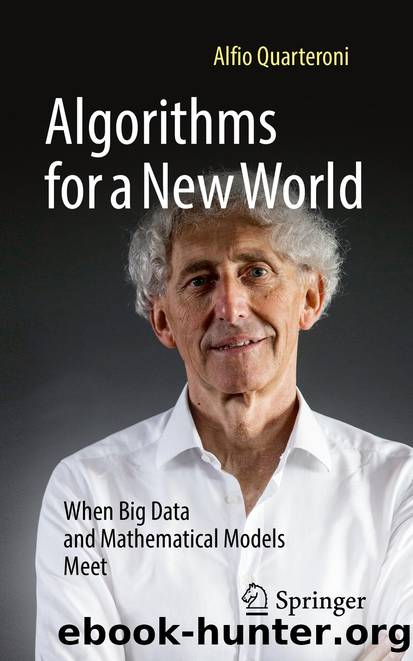Algorithms for a New World by Alfio Quarteroni

Author:Alfio Quarteroni
Language: eng
Format: epub
ISBN: 9783030961664
Publisher: Springer International Publishing
© The Author(s), under exclusive license to Springer Nature Switzerland AG 2022
A. QuarteroniAlgorithms for a New Worldhttps://doi.org/10.1007/978-3-030-96166-4_4
4. Artificial Intelligence, Learning Computers, Artificial Neural Networks
Alfio Quarteroni1, 2
(1)Ãcole Polytechnique Fédérale de Lausanne (EPFL), Lausanne, Switzerland
(2)Politecnico di Milano Dipartimento di Matematica, Milan, Italy
The question Iâd like to answer, not necessarily in this chapter, is the following: can we replace mathematical models with artificial intelligence, more precisely with machine learning algorithms?
Thereâs indeed a growing interest in artificial intelligence (AI). Almost every day we read articles in the media informing us of a sensational new application of artificial intelligence. We should stress that many of these articles are sensationalistic brags, and donât go into the specific merits of the discovery in question. Be that as it may, the expectation thatâs been created at a planetary level gives the discipline an almost magical halo, as has rarely occurred in the past for other subjects.
Itâll take some time to answer the question. It is necessary to define first what AI is. For a mathematician, starting from the definitions is a primary need, almost like breathing. When we have a precise definition we have given ourselves clear reference points, and we have established a logical context in which to operate. With AI the first issues appear soon. In an abstract (and very general) way, we might say that AI is the capacity of computers to imitate cognitive functions of the human mind such as learning and problem solving. Therefore we could simplify by saying that a proof AI exists is the existence of âintelligentâ computers.
The creation of the first intelligent computers probably dates back to the early 1950s, when, thanks to probabilistic methods, we built machines that took into account the probability of occurrence of a certain event. The term artificial intelligence was coined by John McCarthy, a Stanford professor, in 1956. It is not my intention to tell the history (albeit brief) of artificial intelligence. Instead I will limit myself to observe that today, when we think of AI, we are referring to two different paradigms to build intelligent computers. Traditional AI (we might refer to this one as classical), is made of classical programs, that typically use object-oriented languages or symbolic methods and will know how to make decisions (according to the logic of programming IF⦠THENâ¦: if a certain situation occurs, certain consequences follow). Among the numerous fields in which today classical AI is successfully applied we can cite artificial vision, recognition and use of written and spoken language, expert systems, robotics, self-driving cars and public transport.
Let us dwell for a moment on the application to driverless vehicles. Many car manufacturers have made prototypes capable of autonomous driving, even at medium speed on busy roads. These cars use a large number of sensors, cameras and localization systems such as the GPS. These are to all effects a learning system, more and more specific and refined, able to decide whether to brake, suddenly change course or adopt different driving modes depending on the context, after applying an algorithm that takes into account the distance to an obstacle and the cruising speed.
Download
This site does not store any files on its server. We only index and link to content provided by other sites. Please contact the content providers to delete copyright contents if any and email us, we'll remove relevant links or contents immediately.
Exploring Deepfakes by Bryan Lyon and Matt Tora(7412)
Robo-Advisor with Python by Aki Ranin(7299)
Offensive Shellcode from Scratch by Rishalin Pillay(5941)
Ego Is the Enemy by Ryan Holiday(4889)
Microsoft 365 and SharePoint Online Cookbook by Gaurav Mahajan Sudeep Ghatak Nate Chamberlain Scott Brewster(4691)
Management Strategies for the Cloud Revolution: How Cloud Computing Is Transforming Business and Why You Can't Afford to Be Left Behind by Charles Babcock(4414)
Python for ArcGIS Pro by Silas Toms Bill Parker(4014)
Elevating React Web Development with Gatsby by Samuel Larsen-Disney(3722)
Machine Learning at Scale with H2O by Gregory Keys | David Whiting(3430)
Learning C# by Developing Games with Unity 2021 by Harrison Ferrone(3258)
Speed Up Your Python with Rust by Maxwell Flitton(3214)
Liar's Poker by Michael Lewis(3192)
OPNsense Beginner to Professional by Julio Cesar Bueno de Camargo(3180)
Extreme DAX by Michiel Rozema & Henk Vlootman(3154)
Agile Security Operations by Hinne Hettema(3107)
Linux Command Line and Shell Scripting Techniques by Vedran Dakic and Jasmin Redzepagic(3097)
Essential Cryptography for JavaScript Developers by Alessandro Segala(3070)
Cryptography Algorithms by Massimo Bertaccini(2986)
AI-Powered Commerce by Andy Pandharikar & Frederik Bussler(2969)
